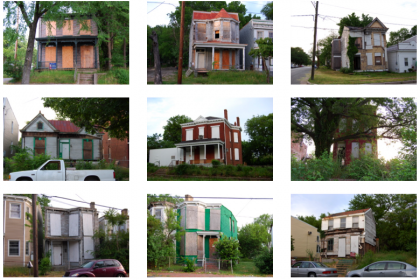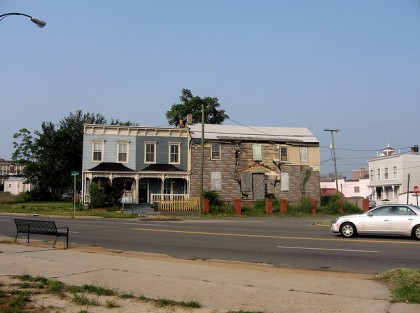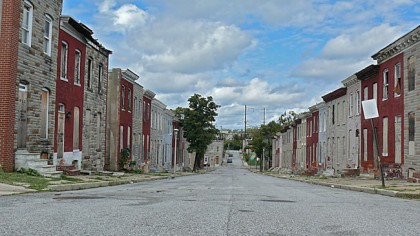RECENT COMMENTS
On Turning Around Vacant Properties in Greater Richmond

More than 100 people turned out to see City of Richmond officials and panelists from Baltimore speak on the state of vacant housing and neighborhood stabilization policy alternatives at a seminar on Friday morning at the Federal Reserve Bank on Byrd Street.
The first panel led off with a presentation by Rachel Flynn, Director of Planning and Development Review (Richmond), on the state of vacant housing in Richmond. The bulk of the vacant houses in Richmond are clustered in the old trolley neighborhoods, which Flynn says saw decline in large part due to the changes in transportation habits and infrastructure through the mid-20th century. Of the 2,400 vacant houses in the city, 1/3 are uninhabitable, 1/3 need some work, and 1/3 could be lived in as-is.
Flynn went on to detail the tools that the city has available to fight vacancy and blight (PDF). One aspect of the fight is using code enforcement as a stick to motivate the neglectful or inaccessible property owner to either fix the property, sell the property, or lose the property. The spot blight program allows the city to get control of vacant properties (such as the Meredith House below). The delinquent tax sale is another means to find new ownership for a house that has been abandoned. As Greg Lukanuski, Assistant Attorney (Richmond), and Bonnie Ashley, Senior Assistant Attorney (Richmond), pointed out later, these processes can both take quite some time and have built-in drawbacks and difficulties.
Richmond also offers a number of carrot programs to motivate blight abatement. These programs are most effective when the property owners are cooperative, but are in areas where there is no market for the property. The lauded Neighborhoods in Bloom program (which offers tax abatement to redeveloped properties) is a prominent example of this. Community development corporations such as Better Housing Coalition and ElderHomes benefit from the tax credits and tax breaks to rehabilitate enough of a targeted area to then create a market for private development.
Lukanuski followed Flynn and spoke on the problems of fighting blight and vacancy using the currently available legal tools. Using the building code as a means to force property maintenance and improvement works well, he said, except when the property owner 1) does not have the financial capability to fix the property, or 2) the property owner can not be reached. The unreachable owner can include inherited properties with myriad owners, out-of-state landlords, and slumlords intentionally avoiding contact.
The second panel featured two speakers from Baltimore, a city famously plagued by vacancy. Jim Kelly, Assistant Professor at the University of Baltimore Law School, led off with a highly anticipated presentation on vacant building receivership. Receivership focusses more on getting a property fixed up, rather than targeting the owner of the property with criminal procedures. The process allows for transfer of the property with a clear title to a new owner who will take on redevelopment of the property. One key difference between this and the current approach in Richmond is that the owner notification process is streamlines and the property owner is not required to appear in court, making the process more nimble. A key target of receivership are owners of vacant, substandard properties that are holding the properties, waiting to profit on the investment of others as the rest of the block or neighborhood comes up around them.
Though the city could be the entity to receive the property, the focus is to get the properties into the hands of developers that will use private money to fix the property. Baltimore has had success with neighborhood stabilization using vacant building receivership with a targeted approach in neighborhoods with between 2-20% vacancy rates. Receivership is effective in areas where there is an existing market for housing and redevelopment can be done successfully one property at a time.
Turning Around Vacant Properties in Greater Richmond
Federal Reserve Bank of Richmond
August 20, 2010









This was an interesting and informative forum. I am glad to see the City and non-profits working together on this complex issue. There was a glaring absence, though: RRHA was neither present nor mentioned. Too bad, as they are undoubtedly an important piece of the puzzle.
To the organizers: thanks for putting this forum together.
The RTD’s Richmond seeks to reduce the number of vacant properties has good coverage of the 1st part of the morning, doesn’t have anything about vacant building receivership.
While not mentioned, RRHA was there. I personally spoke with someone with the housing authority.
Thanks for this report John. For those of us that had to work on Friday and couldn’t make it, it’s good to know what was discussed. I’d like to see a pilot receivership project started in Church Hill this year. Keeping taxes up to date and keeping property within code requirements does very little to actually help the neighborhood. I would think that forcing properties that have been vacant for 5+ years into receivership would be a welcome change to our current situation.
Getting this on the books in Richmond requires getting the approval of the General Assembly. It seems like the city will be pursuing this, but it’ll take some time to get in place.
http://www.oregonhill.net/2010/08/12/ohhic-laurel-street-lots-are-for-sale/
hey before you get wet drawers about this idea read the article by the featured speaker. do you really want to give political groups more power over peoples property rights? if you want to fix up a property buy it and quit trying to figure out ways to screw other people out of their investments. this bullshit is always wrapped up in the argument that it is for the greater good.pardon my disbelief,as i have watched the rise of the supposed non profit hysterical preservationists with disbelief. everybody has an agenda and everybody who works for these folks gets a paycheck. naturally they are interested in PRESERVING their own careers.can we please quit acting as if this is NOT a factor in their push for more ways to castrate property owners who dont wish to dance to the party tune. geez!buddycorbett
how nice it must be for these groups to have the upper hand as their own projects seem to sail thru approval under blue skies. how many buildings do folks conncted to regulatory groups get to build in the neighborhood without suffering under the yoke of uber regulation as do the rest of us? if you want to be on a group like CAR you should not be allowed to do business in the districts you oversee. in any other city this would be called a conflict of interest. if you want towork on your own projects resign. otherwise people with brains will wonder how you are allowed an inside track to do business where the rest of us possess no such crutch. just asking what the rest of you think.buddycorbett
Many of the presentations from this are now available on the Federal Reserve Bank of Richmond event site.
buddy- the receivership program is designed to be used (as described) for those properties that will not sell to investors that want to purchase the homes and make the necessary improvements. It would also offer an accelerated option to current agonizingly slow blight abatement processes.
That said, private property rights groups will have a problem with the program. It’s design and implementation will certainly need to be weighed carefully. However, I think this goes to the property rights of everyone in the neighborhood. All other homeowners on a block shouldn’t be subjected to declining property values just because an owner can’t be identified or motivated to maintain their property.
Does anyone know anything about 2204 E Broad and what the story is there? It’s in a row of really nicely renovated homes and sticks out like a sore thumb. It appears to have been vacant for a while but I can’t figure out why nobody would have snatched this up by now or why the owner wouldn’t try to sell instead of letting it go to rot. Doesn’t appear from zillow that anyone has even attempted to sell it.
Owner is listed as Evelyn Pearsall who seems to own a bunch of properties all around town. Hadn’t heard the name before on the list of abandoned property owners but it seems odd that a perfectly good house is just sitting vacant this long.
Evelyn Pearsall owns several properties in the area, as you said, and her son, Billy controls them. There have been several people over the years who have tried to buy them, but the Pearsalls won’t sell anything. It is just the way some of the older families act in this neighborhood. Eventually it will change and this one will be given the loving attention it deserves.
Pearsall: /2010/03/03/john-wesley-pearsall_12459/
John, thanks for the link. Fascinating read. I knew I had heard that name somewhere before and hadn’t connected it to the Patience Gromes story. Nice when I can find an answer to a question that’s been nagging me for a while…
Sadly, it doesn’t sound like that house will be getting the love it deserves for a while. There’s only a few houses on our block holding it back from being in great shape but they seem to be stubborn ones.
John,
John W. Pearsall is not the same family as Evelyn Pearsall. Distant relation, maybe, but not the same.
The comments on that earlier had info about Evelyn Pearsall.